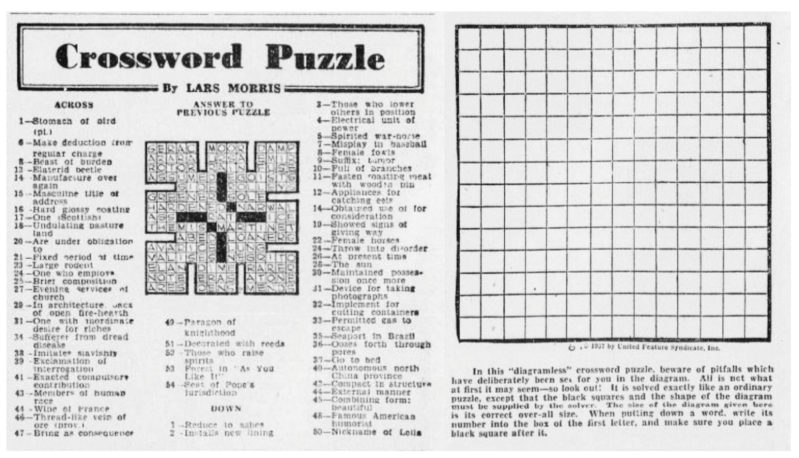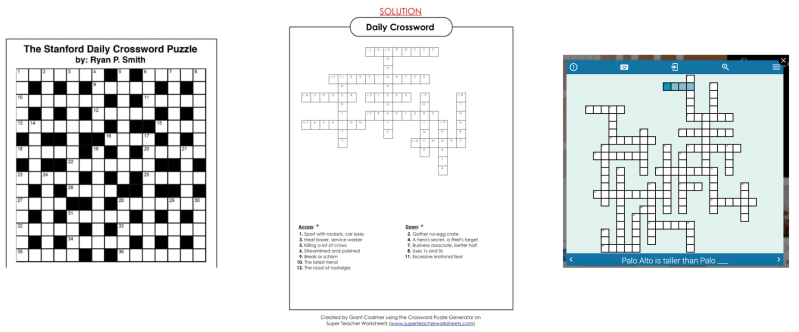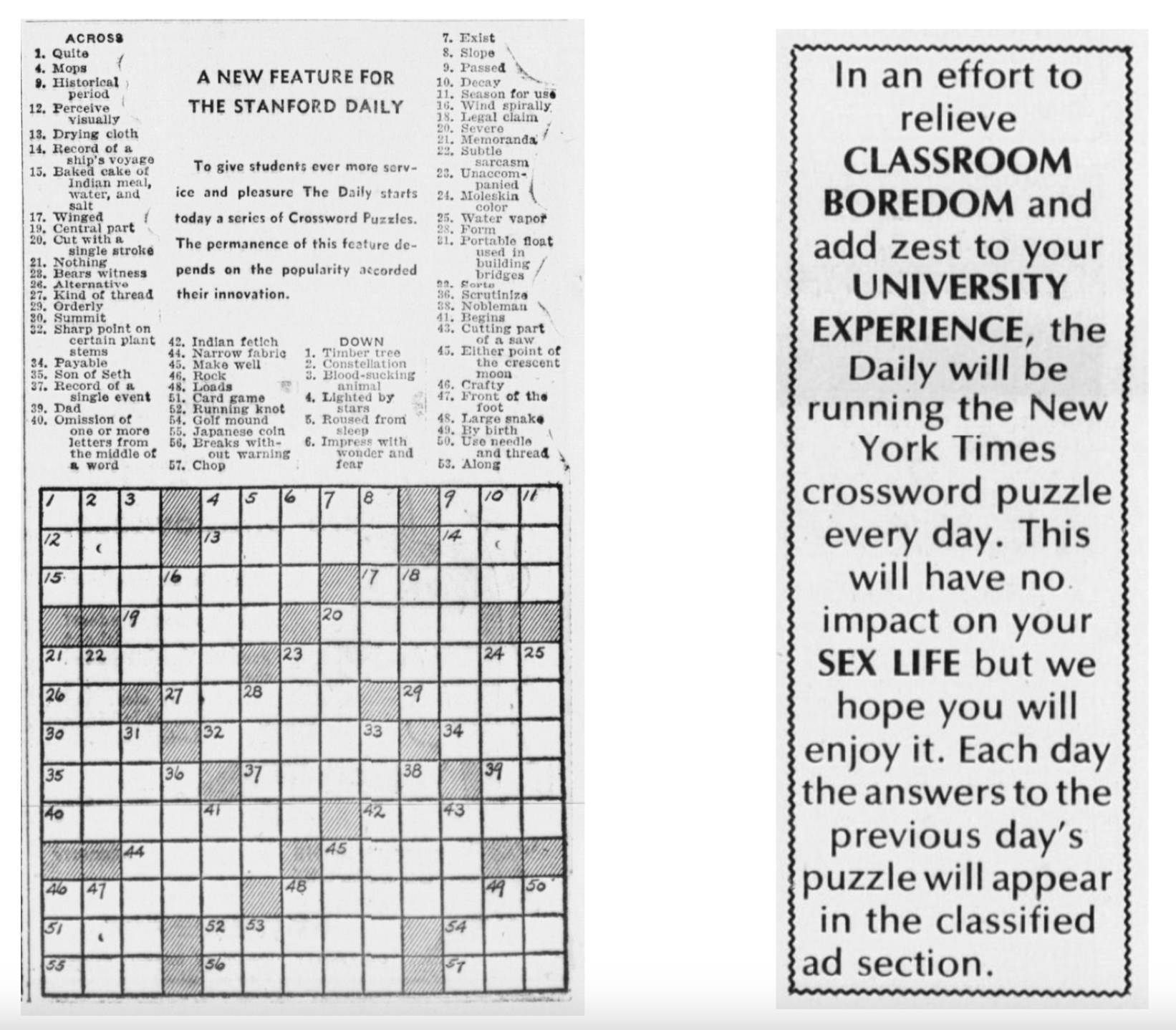On April 2, 1935, The Stanford Daily announced its first crossword with great fanfare. “To give students ever more service and pleasure The Daily starts today a series of Crossword Puzzles,” it wrote. “The permanence of this feature depends on the popularity accorded their innovation.”
The crossword proved popular, but not without its changes and controversies through its 88-year history. It has been canceled and revived many times, each time with its own flavor. Paging through the archives, you discover the spirit of Stanford’s many word nerds through the ages.
For example, the prim formality of the 1930s announcement gave way to the boisterous ’70s. The Daily announced the crossword’s return in 1978 “to relieve classroom boredom and add zest” to student life. “This will have no impact on your sex life,” they admitted cheekily, “but we hope you will enjoy it.”
A welcome distraction
For most of its history, The Daily crossword was a mindless in-class distraction for tired students. Before cell phones, the best way to entertain yourself in a dreary lecture was to pull out that morning’s edition of The Daily and work on the crossword. An informal poll in 1986 concluded that one in four Daily readers went straight to the crossword when they opened the paper and reported that many saved it for class.
The puzzle’s role in distracting and entertaining the student body may seem trivial, but the history of the crossword in major newspapers suggests that it provides a vital service. The New York Times initially refused to publish a crossword, calling it a “sinful waste,” but was convinced to do so in the midst of World War II. Margaret Farrar, the first crossword editor for the Times, decided that the world needed a distraction from the tragedies.
Reader rage
The Daily crossword has changed hands numerous times throughout the feature’s history, from various companies that sell syndicated crosswords to students taking up the mantle of “Crossword Editor.” The changes always spur strong reactions from readers, reflecting the essential place that puzzles hold in their hearts.
Whenever the puzzle was canceled or suspended, readers complained. The first run of the crossword ended after just two months in 1935, and letters to the editor poured in. “I used to work industriously at them in my cold, cold 8 o’clocks, but since you’ve done away with them I have no incentive to scramble out of bed and wend my way to class,” one puzzler protested.
When the crossword was canceled in 1968, 39 students signed a petition “respectfully requesting of the powers that be that our educational and entertainment goals and desires be fulfilled by the inclusion of a crossword puzzle in the venerable Daily.” The Daily editors claimed the crossword was “not worth it” and canceled it again in 1974, but four years later, they began publishing syndicated New York Times crosswords every day.
At certain points, students have disparaged The Daily’s crosswords. Tribune Media Services, a provider of the crosswords, drew anger during its 11-year reign in the early 2000s. The puzzles it provided were lambasted as a “sad excuse for an inkblot.” Columnist Barrett Sheridan ’06 claimed that “The Daily crossword deserve[d] to die” for its simple but poorly worded clues, clunky formatting and lack of creative wordplay. Students longed for the creativity of The New York Times crossword, which The Daily had stopped publishing in 2003 due to its “prohibitive” cost and had replaced with the cheaper Tribune crossword.

Clever crosswords through the years
Indeed, the Tribune Media puzzles were a step down from the clever puzzles of Stanford’s past. The very first Stanford crossword was published not by The Daily but by the satirical campus magazine “The Chaparral,” which made a puzzle with humorous and scandalous clues in 1925. 10 years later, The Daily followed suit.
In the first era of The Daily crosswords, clues were not very creative, primarily basing themselves in definitions and facts, such as “Son of Seth” for the answer ENOS or “Memoranda” for NOTES. The next provider, the United Feature Syndicate, incorporated variety in the late 1930s. One of the most daring was a diagramless puzzle, in which puzzlers were given a blank grid and had to ink in their own structural black squares as well as the answers to fill it.

In the 1980s and ’90s, creative and accessible puzzles became the norm, including twists like puns, anagrams and pop culture jokes. Particularly clever clues get question marks (like “Many moons?” for DERRIERES).
Some puzzles even get creative personal touches. A Stanford graduate student set the trend of using crosswords as a marriage proposal in 1991. Seven years later, a New York Times crossword helping two lawyers get engaged with a bespoke puzzle was republished in The Daily’s pages (hopefully no smitten Stanford students mistook the puzzle as a proposal for them). The puzzle, featuring clues such as “1729 Jonathan Swift pamphlet, with ‘A’” for MODEST PROPOSAL, fed the general Stanford appetite for witty clues with double meanings.
In the 2010s, student editors changed the style of The Daily’s crossword. They abandoned the classic thick clumps of interlocking words in favor of sparse intersections of fewer words with more clever clues. As a result, Stanford-specific clues exploded, like “Palo Alto is shorter than Palo ___” for an answer of BAJO.
However, in the process, editors abandoned fundamental features of traditional crosswords — creating symmetrical patterns, minimizing blank space and maximizing intersections and extended blocks of letters. Only in the last year have the puzzles returned to the gold standard of crossword formatting, with current editor Peyton Lee ’24 combining clever themed clues with more standard layouts.

The Daily Crossword in the digital age
In the dawn of the internet, physical newspapers underwent a transition and their puzzles along with it. Many students in the 2000s got their crossword fix through paper copies of the New York Times provided by a campus news readership program, but when the program was defunded in 2007, puzzle enthusiasts were left without physical access to the high-quality crossword. This paralleled a nationwide transition into digital puzzles that The Daily has been slow to catch up with.
The Daily’s crossword first incorporated technology when the paper provided a phone number to get answers on particularly tough clues in the 1990s. Then, answers moved online in 2013, but the crossword was published only in hard copy.
The first interactive digital crossword, complete with autocheck and navigable by keystroke, was launched in 2021 by Matthew Turk ’24 for The Daily Magazine, mirroring the successful digital puzzles of the New York Times. Lee’s current revamp of the crossword centers around the old-fashioned appeal of pen and paper and traditional 15×15 grids. Currently, The Daily’s website can’t support a full interactive crossword, but the publication hopes to digitize the puzzle soon.
Student editors take the reins
After a long history of subscribing to syndicated crosswords, The Daily began appointing student crossword editors in 2013, with Ryan Smith ’17 inaugurating the role. The roles continue today with Lee as editor and Bella Meyn ’23, Ashley Larson ’23 and Lana Tleimat ’24 as contributors. In 2022, Meyn, Larson and Tleimat became the first women to have crossword puzzle credits in The Daily, after 87 years of men authoring the feature. There has yet to be a female editor of The Daily’s crossword.
The new crossword team is the first group of student crossword creators in The Daily’s history to consistently and ambitiously combine shrewdness of clues with the standard 15×15 grid and strict rules of crossword setting.
Sheridan, the 2006 columnist who criticized the Tribune’s crossword, wrote to The Daily in praise of today’s student puzzle-makers. He advised The Daily’s crossword creators to “keep it current and whimsical.”
He argued that, unlike bigger newspapers, The Daily has the flexibility and youthfulness to use “fresh slang” and “of-the-moment cluing” that will make its crossword “relevant and timely, not eternal and placeless.”
The crossword underwent numerous transformations throughout The Daily’s history. Its appeal, though, stretches across time: there’s nothing like the thrill of understanding a certain pun and filling in the final squares. The current iteration of the crossword is published in this issue, and the clues are taken from facts from this article.
Editor’s Note: This article is a review and includes subjective thoughts, opinions and critiques.
